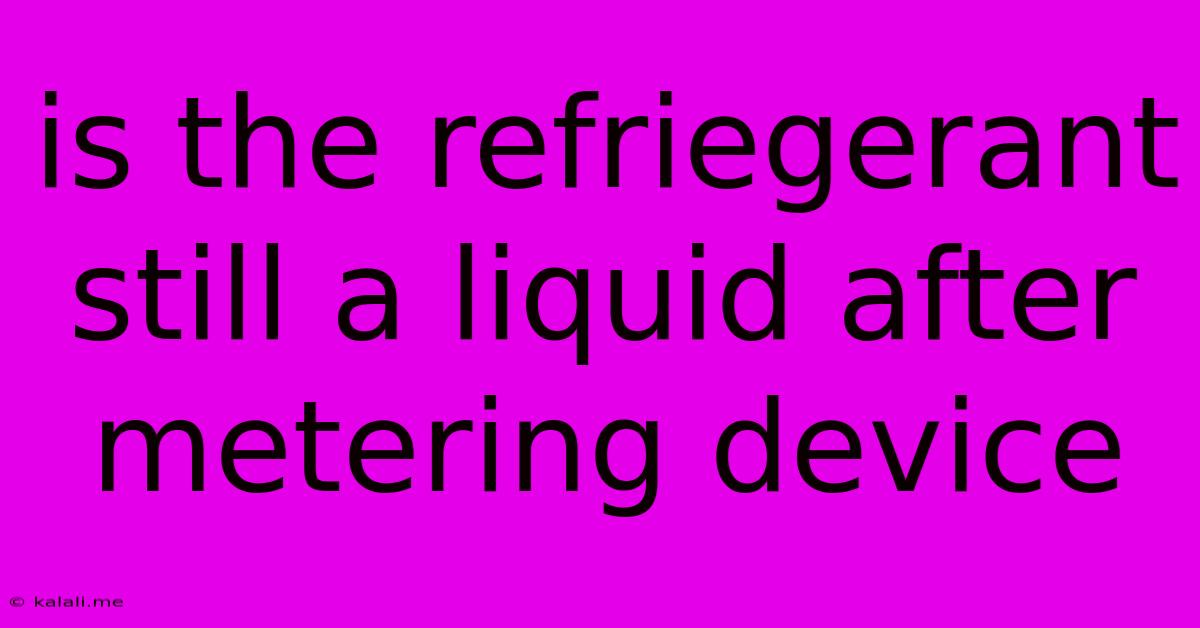Is The Refriegerant Still A Liquid After Metering Device
Kalali
Jun 07, 2025 · 3 min read

Table of Contents
Is the Refrigerant Still a Liquid After the Metering Device? It's Complicated!
The question of whether refrigerant remains a liquid after passing through the metering device is a crucial one in understanding refrigeration cycles, but the simple answer is: not necessarily. It's more accurate to say that the refrigerant's state is a complex mixture, often a combination of liquid and vapor, and the precise proportion depends on several factors. This article will delve into the intricacies of this process, exploring the role of the metering device and the factors influencing the refrigerant's state downstream.
The metering device, be it a capillary tube, expansion valve, or electronic expansion valve, plays a vital role in regulating the refrigerant flow into the evaporator. Its primary function is to reduce the refrigerant's pressure, causing a subsequent temperature drop. This pressure reduction is crucial for the refrigerant to absorb heat from the space being cooled in the evaporator. Understanding the consequences of this pressure drop is key to answering our central question.
The Role of the Metering Device in Refrigerant Phase Change
The metering device's job isn't simply to control flow rate; it's to create a specific pressure drop that induces a phase change in the refrigerant. Ideally, the refrigerant entering the evaporator should be a mixture of liquid and vapor – a "flash gas" – to optimize heat absorption.
- Complete Liquid: If the refrigerant remains entirely liquid after the metering device, it indicates an over-feeding condition. This means the metering device isn't reducing the pressure sufficiently, leading to reduced cooling efficiency and potential damage to the compressor.
- Complete Vapor: Conversely, if the refrigerant is entirely vapor after the metering device, it indicates under-feeding. The evaporator won't receive enough liquid refrigerant to absorb heat effectively, resulting in poor cooling performance.
- Optimal Mixture (Flash Gas): The most efficient scenario is a mixture of liquid and vapor, often referred to as "flash gas." This ensures optimal heat transfer in the evaporator. The exact proportion of liquid to vapor depends on several factors, including the refrigerant type, metering device design, and system operating conditions.
Factors Influencing Refrigerant State Downstream of the Metering Device
Several factors determine whether the refrigerant is predominantly liquid, vapor, or a mixture after the metering device:
- Refrigerant Type: Different refrigerants have different thermodynamic properties, influencing their behavior during the pressure drop across the metering device.
- System Operating Conditions: Ambient temperature, load on the system (how much cooling is required), and the evaporator's temperature all play a significant role.
- Metering Device Type and Sizing: The type and size of the metering device directly influence the pressure drop and the resultant refrigerant state. A poorly sized capillary tube or expansion valve can lead to inefficient operation.
- System Charge: An incorrect refrigerant charge can dramatically impact the refrigerant's state after the metering device. Overcharging can lead to excessive liquid, while undercharging can result in insufficient refrigerant.
Diagnosing Refrigerant State Issues
Understanding the refrigerant's state after the metering device is crucial for diagnosing refrigeration system problems. Service technicians use specialized tools and techniques, including temperature and pressure measurements, to assess the refrigerant's condition and identify potential issues. Incorrect refrigerant state often indicates problems with the metering device itself, improper refrigerant charge, or other system malfunctions.
In conclusion, determining whether the refrigerant is a liquid after the metering device is not a straightforward yes or no answer. The optimal state is a mixture of liquid and vapor, and achieving this balance is vital for efficient and reliable refrigeration system operation. Many factors influence the final state, and understanding these nuances is key to effective troubleshooting and maintenance.
Latest Posts
Latest Posts
-
Can I Replac Ea Porch Nail With A Along Screw
Jun 07, 2025
-
Wire For A 200 Amp Service
Jun 07, 2025
-
Different Kinds Of Objects That Change
Jun 07, 2025
-
Why Does My Dog Lick Her Paws
Jun 07, 2025
-
Could You Do Me A Solid
Jun 07, 2025
Related Post
Thank you for visiting our website which covers about Is The Refriegerant Still A Liquid After Metering Device . We hope the information provided has been useful to you. Feel free to contact us if you have any questions or need further assistance. See you next time and don't miss to bookmark.